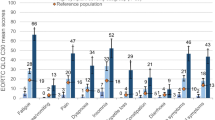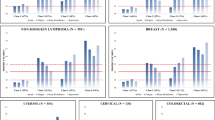Abstract
Purpose
The purposes of this study, in a sample of women with breast cancer receiving chemotherapy (CTX), were to identify subgroups of women with distinct experiences with the symptom cluster of pain, fatigue, sleep disturbance, and depressive symptoms and evaluate differences in demographic and clinical characteristics, differences in psychological symptoms, and differences in pain characteristics among these subgroups.
Methods
Patients completed symptom questionnaires in the week following CTX administration. Latent class profile analysis (LCPA) was used to determine the patient subgroups.
Results
Three subgroups were identified: 140 patients (35.8 %) in the “low,” 189 patients (48.3 %) in the “moderate,” and 62 patients (15.9 %) in the “all high” latent class. Patients in the all high class had a lower functional status, a higher comorbidity profile, a higher symptom burden, and a poorer quality of life.
Conclusions
Study findings provide evidence of the utility of LCPA to explain inter-individual variability in the symptom experience of patients undergoing CTX. The ability to characterize subgroups of patients with distinct symptom experiences allows for the identification of high-risk patients and may guide the design of targeted interventions that are tailored to an individual’s symptom profile.

Similar content being viewed by others
References
van den Beuken-van Everdingen MHJ, de Rijke JM, Kessels AG et al (2007) Prevalence of pain in patients with cancer: a systematic review of the past 40 years. Ann Oncol 18:1437–1449
Miaskowski C, Dibble SL (1995) The problem of pain in outpatients with breast cancer. Oncol Nurs Forum 22:791–797
Portenoy RK (1989) Cancer pain. Epidemiology and syndromes. Cancer 63:2298–2307
Miaskowski C, Cooper BA, Paul SM et al (2006) Subgroups of patients with cancer with different symptom experiences and quality-of-life outcomes: a cluster analysis. Oncol Nurs Forum 33(5):E79–E89
Miaskowski C, Lee KA (1999) Pain, fatigue, and sleep disturbances in oncology outpatients receiving radiation therapy for bone metastasis: a pilot study. J Pain Symptom Manage 17:320–332
Pud D, Ami SB, Cooper BA et al (2008) The symptom experience of oncology outpatients has a different impact on quality of life outcomes. J Pain Symptom Manage 35:162–170
Illi J, Miaskowski C, Cooper B et al (2012) Association between pro- and anti-inflammatory cytokine genes and a symptom cluster of pain, fatigue, sleep disturbance, and depression. Cytokine 58:437–447. doi:10.1016/j.cyto.2012.02.015
Dodd MJ, Cho MH, Cooper BA, Miaskowski C (2010) The effect of symptom clusters on functional status and quality of life in women with breast cancer. Eur J Oncol Nurs 14:101–110
Dodd MJ, Cho MH, Cooper BA et al (2011) Identification of latent classes in patients who are receiving biotherapy based on symptom experience and its effect on functional status and quality of life. Oncol Nurs Forum 38:33–42
Karnofsky D, Abelmann WH, Craver LV, Burchenal JH (1948) The use of nitrogen mustard in the palliative treatment of cancer. Cancer 1:634–656
Sangha O, Stucki G, Liang MH, Fossel AH, Katz JN (2003) The Self-Administered Comorbidity Questionnaire: a new method to assess comorbidity for clinical and health services research. Arthritis Rheum 49:156–163
Cleeland CS, Ryan KM (1994) Pain assessment: global use of the Brief Pain Inventory. Ann Acad Med Singap 23:129–138
Carpenter JS, Andrykowski MA (1998) Psychometric evaluation of the Pittsburgh sleep quality index. J Psychosom Res 45:5–13
Sheehan TJ, Fifield J, Reisine S, Tennen H (1995) The measurement structure of the Center for Epidemiologic Studies Depression Scale. J Pers Assess 64:507–521
Lee KA (1992) Self-reported sleep disturbances in employed women. Sleep 15:493–498
Lee KA, Hicks G, Nino-Murcia G (1991) Validity and reliability of a scale to assess fatigue. Psychiatry Res 36:291–298
Fletcher BS, Paul SM, Dodd MJ et al (2008) Prevalence, severity, and impact of symptoms on female family caregivers of patients at the initiation of radiation therapy for prostate cancer. J Clin Oncol 26:599–605. doi:10.1200/JCO.2007.12.2838
Spielberger CG, Gorsuch RL, Suchene R, Vagg PR, Jacobs GA (1983) Manual for the State-Anxiety (Form Y): self evaluation questionnaire. Consulting Psychologists Press, Palo Alto
Bieling PJ, Antony MM, Swinson RP (1998) The State-Trait Anxiety Inventory, trait version: structure and content re-examined. Behav Res Ther 36:777–788
Cimprich B (1992) Attentional fatigue following breast cancer surgery. Res Nurs Health 15:199–207
Jansen CE, Dodd MJ, Miaskowski CA, Dowling GA, Kramer J (2008) Preliminary results of a longitudinal study of changes in cognitive function in breast cancer patients undergoing chemotherapy with doxorubicin and cyclophosphamide. Psychooncology 17:1189–1195. doi:10.1002/pon.1342
Ferrell BR, Wisdom C, Wenzl C (1989) Quality of life as an outcome variable in the management of cancer pain. Cancer 63:2321–2327
Padilla GV, Presant C, Grant MM, Metter G, Lipsett J, Heide F (1983) Quality of life index for patients with cancer. Res Nurs Health 6:117–126
Nylund KL, Asparouhov T, Muthen BO (2007) Deciding on the number of classes in latent class analysis and growth mixture modeling: a Monte Carlo simulation study. Struct Equ Model 14:535–569
Celeux G, Soromenho G (1996) An entropy criterion for assessing the number of clusters in a mixture model. J Classif 13:195–212
Collins LM, Wugalter SE (1992) Latent class models for stage-sequential dynamic latent variables. Multivar Behav Res 27:131–157
Lanza ST, Flaherty BP, Collins LM (2003) Latent class and latent transition analysis. In: Schinka JA, Velicer WF (eds) Handbook of psychology: research methods in psychology. John Wiley & Sons, Inc, Hoboken, pp 663–685
Muthen LK, Muthen BO (1998-2012) Mplus user’s guide (7th ed.). Muthen & Muthen, Los Angeles, CA
Muthen B, Shedden K (1999) Finite mixture modeling with mixture outcomes using the EM algorithm. Biometrics 55:463–469
Paul SM, Zelman DC, Smith M, Miaskowski C (2005) Categorizing the severity of cancer pain: further exploration of the establishment of cutpoints. Pain 113:37–44
Lewinsohn PM, Seeley JR, Roberts RE, Allen NB (1997) Center for Epidemiologic Studies Depression Scale (CES-D) as a screening instrument for depression among community-residing older adults. Psychol Aging 12:277–287
Kroenke CH, Kwan ML, Neuget AI, Ergas IJ, Wright JD, Caan BJ, Hershman D, Kushi LH (2013) Social networks, social support mechanisms, and quality of life after breast cancer diagnosis. Breast Cancer Res Treat 139:515–527
Dodd MJ, Miaskowski C, Paul SM (2001) Symptom clusters and their effect on the functional status of patients with cancer. Oncol Nurs Forum 28:465–470
Kim HJ, Barsevick AM, Beck SL, Dudley W (2012) Clinical subgroups of a psychoneurologic symptom cluster in women receiving treatment for breast cancer: a secondary analysis. Oncol Nurs Forum 39:E20–E30
So WK, Marsh G, Ling WM et al (2009) The symptom cluster of fatigue, pain, anxiety and depression and the effect on the quality of life of women receiving treatment for breast cancer: a multicenter study. Oncol Nurs Forum 36:E205–E214
Gonzalez P, Castaneda SF, Dale J et al (2014) Spiritual well-being and depressive symptoms among cancer survivors. Support Care Cancer 22:2393–2400
Myers S (2008) Proinflammatory cytokines and sickness behavior: implications for depression and cancer-related symptoms. Oncol Nurs Forum 35:802–807
Dantzer R (2001) Cytokine-induced sickness behavior: mechanisms and implications. Ann N Y Acad Sci 933:222–234
Doong SH, Dhruva A, Dunn LB et al (2015) Associations between cytokine genes and a symptom cluster of pain, fatigue, sleep disturbance, and depression in patients prior to breast cancer surgery. Biol Res Nurs 17:237–247
Acknowledgements
This study was funded by the National Cancer Institute (CA134900). Dr. Miaskowski is an American Cancer Society (ACS) Clinical Research Professor and has a K05 award from the National Cancer Institute (CA168960). Dr. Langford was supported by a Department of Defense Breast Cancer Research Program Postdoctoral Fellowship.
Conflict of interest
The authors have no conflicts of interest to declare. The authors had primary control over all of the data and agree to allow the journal to review the date if requested.
Author information
Authors and Affiliations
Corresponding author
Rights and permissions
About this article
Cite this article
Langford, D.J., Paul, S.M., Cooper, B. et al. Comparison of subgroups of breast cancer patients on pain and co-occurring symptoms following chemotherapy. Support Care Cancer 24, 605–614 (2016). https://doi.org/10.1007/s00520-015-2819-1
Received:
Accepted:
Published:
Issue Date:
DOI: https://doi.org/10.1007/s00520-015-2819-1




